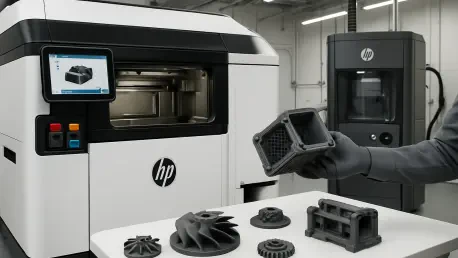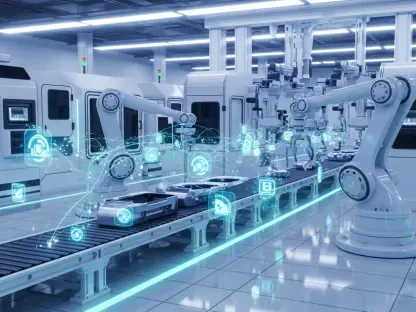In a world where industrial innovation races ahead at breakneck speed, additive manufacturing stands as a cornerstone for transforming how products are designed and produced across countless sectors. At Formnext, a flagship event for the 3D printing industry held this year, HP emerged as a dominant force, revealing a suite of groundbreaking technologies and strategic alliances that underscore its ambition to redefine the global landscape of additive manufacturing. The company’s latest unveilings span advanced materials for specialized applications, a surprising re-entry into filament-based printing, and robust digital initiatives aimed at streamlining access to 3D printing solutions. These announcements signal HP’s intent to not only keep pace with market demands but to actively shape the future of industrial production. With a clear focus on versatility and scalability, HP is positioning itself as a leader capable of addressing the nuanced needs of diverse industries, from high-performance computing to heavy manufacturing, through a carefully crafted ecosystem of innovation.
Advancing Material Solutions for Industry Needs
At the heart of HP’s recent showcase is a strong emphasis on material innovation, particularly for its Metal Jet platform, which continues to push boundaries in additive manufacturing. A key development is the focus on copper, tailored for thermal management applications critical to high-performance computing and data centers. This initiative builds on longstanding collaborations with industry players like GKN Powder Metallurgy, reflecting a strategic response to the growing demand for efficient heat dissipation in cutting-edge tech environments. Beyond copper, HP has also partnered with INDO-MIM and Continuum Powders to qualify advanced nickel-based superalloys, such as OptiPowder Ni718 and OptiPowder M247LC, the latter developed alongside Basque research center TECNALIA. These materials are engineered to meet stringent requirements in sectors requiring exceptional durability and resistance, demonstrating HP’s commitment to solving complex industrial challenges through targeted material advancements.
The significance of these material breakthroughs extends beyond mere technical achievement, as they highlight HP’s broader vision of catering to niche markets with highly specialized needs. The focus on copper, for instance, taps directly into the urgent requirements of data centers, where thermal efficiency can make or break operational success. Similarly, the introduction of nickel-based superalloys positions HP as a vital partner for industries like aerospace and energy, where components must withstand extreme conditions without compromising performance. This dual approach of addressing both current and emerging demands ensures that HP’s Metal Jet platform remains a competitive force in additive manufacturing. Moreover, these developments are not just about expanding a catalog of materials but about fostering trust among industrial clients who rely on consistent, high-quality outputs for their most critical applications, thereby solidifying HP’s reputation as an innovator in material science for 3D printing.
Revitalizing Filament-Based Industrial Printing
In a surprising yet strategic pivot, HP announced its return to the filament-based 3D printing market with two new industrial-grade printers set for release in 2026: the HP Industrial Filament 3D Printer 600 High Temperature (HP IF 600HT) and the HP Industrial Filament 3D Printer 1000 XL (HP IF 1000 XL). This move challenges the prevailing narrative that low-cost Fused Deposition Modeling (FDM) systems have overshadowed industrial solutions in recent years. By re-entering this segment, HP is betting on the sustained relevance of high-end systems that prioritize precision and reliability over affordability. These printers are designed to cater to specific manufacturing applications where quality cannot be compromised, signaling a belief that there remains a substantial market for robust industrial equipment despite the influx of budget-friendly alternatives dominating headlines.
This strategic re-entry also speaks to HP’s broader intent to diversify its hardware portfolio and capture a wider range of industrial clients. The upcoming printers are not merely a nostalgic return to past technologies but a calculated effort to address gaps in the market where industrial-grade filament printing still holds significant value. For industries requiring rapid prototyping or small-batch production with exacting standards, these systems promise to deliver unmatched consistency and durability. HP’s confidence in this venture suggests a deep understanding of evolving manufacturing needs, particularly in sectors that demand a balance between cost-efficiency and superior output. By positioning itself as a provider of both cutting-edge binder jetting and traditional filament solutions, HP is crafting a versatile lineup of offerings that can adapt to varied customer priorities, reinforcing its role as a comprehensive player in the additive manufacturing arena.
Strengthening Digital and Regional Networks
On the digital front, HP is making significant strides to enhance accessibility and connectivity through initiatives like the HP Additive Manufacturing Network (AMN) program, designed to bridge parts demand with its expansive partner ecosystem. A standout collaboration with Würth Additive Group integrates HP’s additive manufacturing portfolio into a digital inventory services platform, paving the way for a future where ordering 3D printed parts could become as seamless as traditional procurement processes. This partnership hints at a transformative shift in how businesses access additive manufacturing solutions, reducing friction and enabling faster adoption across industries. Such digital integration reflects HP’s forward-thinking approach to not only producing cutting-edge technology but also ensuring it reaches clients efficiently and effectively.
Complementing its digital efforts, HP is also investing in regional support structures, as evidenced by the establishment of the HP Metal Jet Adoption Center in Spain. This facility is poised to provide localized expertise and resources, ensuring that customers in the region have direct access to training, technical support, and tailored solutions. This move underscores a commitment to fostering closer relationships with clients by addressing their specific geographic and operational needs. By combining digital platforms with physical hubs, HP is creating a cohesive network that enhances user experience and builds trust among industrial partners. These initiatives collectively aim to lower barriers to entry for businesses exploring additive manufacturing, while also reinforcing HP’s global presence with a localized touch, ensuring that support is never far from reach for those integrating 3D printing into their workflows.
Driving the Future of Additive Manufacturing
HP’s comprehensive strategy, as showcased at this year’s Formnext, goes beyond simply meeting current market demands—it actively seeks to redefine the trajectory of additive manufacturing. By targeting high-growth verticals such as data centers with copper-based binder jetting solutions, HP is tapping into areas with immense potential for innovation and impact. Simultaneously, the reintroduction of industrial filament printers challenges skepticism about the relevance of high-end systems, positioning HP as a defender of quality and precision in a market increasingly swayed by cost considerations. This dual focus on emerging technologies and traditional strengths illustrates a nuanced understanding of industry dynamics, ensuring relevance across diverse manufacturing landscapes.
Looking ahead, HP’s blend of material advancements, hardware diversification, and digital integration points to a future where additive manufacturing becomes more accessible and adaptable to varied industrial needs. The strategic alliances forged with key industry players add credibility and depth to these efforts, amplifying their potential reach. As companies worldwide grapple with evolving production challenges, HP’s proactive steps in building a robust ecosystem—spanning technology, partnerships, and regional support—offer a blueprint for navigating the complexities of modern manufacturing. These initiatives, unveiled at Formnext, set a benchmark for innovation, encouraging industry stakeholders to explore how such comprehensive approaches could unlock new efficiencies and opportunities in their own operations over the coming years.









